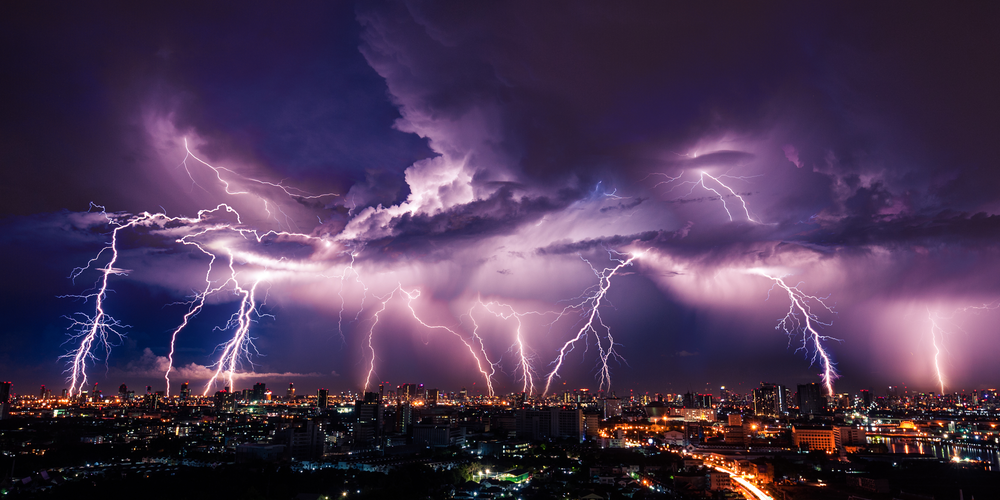
Lightning Strikes: Important Information from Keefe Insurance
With the start of the summer season, we’ll be experiencing some dramatic thunder storms, with heavy rain and sometimes hail. According to the National Weather Service, there are 25 million cloud-to-ground lightning strikes and about 300 people struck by lightning annually. On average, 30 of those people die and the rest often suffer some lifelong disabilities.
Many lightning victims say they were “caught outside” and couldn’t get to a safe place. Others simply waited too long to seek shelter. Others were struck because they went outside too soon after the storm. Still others were struck inside their home while using electrical equipment, corded phones or were in contact with plumbing, outside doors and window frames, not realizing these are electrical conductors during storms.
In the interest of a safe summer, we’re providing some information on how to avoid lightning tragedies that you may want to share with your family members.

Lightning Facts You May Not Know
* All thunderstorms produce lightning and are dangerous. Fortunately, following a few simple guidelines will keep you and your family safe.
* Lightning often strikes outside the area of heavy rain and can strike 10 miles away from the rain. Many lightning deaths occur before the rain arrives or after it stops.
* If you can hear the thunder, you are in danger. Don’t let the blue skies fool you. If you can hear the thunder, lightning is close enough to be an immediate threat.
* Lightning leaves many victims with permanent disabilities. While just 10% die, many survivors suffer permanent damage such as intense pain, neurological disabilities, depression, and other major health issues.
More information on lightning safety is available at www.weather.gov/lightning
Avoid the Threat
Here’s some of the steps you can take to remain safe.
- Have a lightning safety plan. Know where you’ll go for safety and be sure you have enough time to get there. Stadiums and other outdoor venues should have a lightning safety plan. If you are at a sporting event or concert, listen for their directions on where to go.
- Postpone activities. If thunderstorms are predicted, consider postponing or moving to an indoor venue.
- Monitor the weather. If you are already outside, look for signs of developing or approaching storms. Look for towering clouds, darkening skies, or flashes of lightning.
- Get to a safe place.When you hear the thunder, seek shelter immediately. Fully enclosed, non-concrete buildings with wiring and plumbing are best. A hard-topped vehicle with closed windows is also safe. Sheds, picnic shelters, tents or covered porches DO NOT protect you from lightning.
- If you hear thunder, avoid using a corded phone.Cordless phones and cell phones are OK to use.
- Keep away from electrical equipment and plumbing.Lightning can travel though wiring and plumbing if your building is struck. Don’t take a shower or bath, or wash dishes during a storm.
- Stay away from concrete walls and floors.Electricity can travel through the rebar, metal pipes or wires in the concrete.
- Stay inside for at least 30 minutes after the last rumble of thunder.
What If You Get Caught Outside?
If you can’t get to a building or vehicle, there are still things you can do to minimize your risk.
* Avoid open areas. Don’t be the tallest object in the area.
* Stay away from isolated tall trees, towers or utility poles. Lightning tends to strike the taller objects in the area.
* Stay away from metal conductors such are wires or fences. Metal does not attract lightning but the current can travel long distances through it.
* If you are with a group of people, spread out.While this doesn’t decrease the chance that someone may be struck, at least you avoid multiple casualties.
* If you own pets or livestock, such are horses, bring them inside when thunderstorms are predicted. Don’t wait for the thunder to start. Many pets are terrified by thunder and will be difficult to handle once the storm starts. You can get seriously hurt if they panic.
Cardiac arrest is the immediate cause of death for those who die. Lightning victims do not carry an electrical charge, so you can feel safe rendering immediate assistance.
- Call for help. Someone needs to call 911 immediately.
- Give first aid. Begin CPR if you are trained.
- Use an automatic defibrillator if one is available,
- Move the victim to a safer place. Lightning can strike twice!
When it comes to insuring your family’s home, vehicles, possessions and lifestyle, we take our responsibility to keep you properly protected very seriously. The trust you placed in us when you chose the Keefe Insurance Agency means you count on us to keep you informed of things you can do to avoid potential claims.
We are always available during business hours to answer your questions or address your concerns. Stop by or call us at 508-528-3310 or toll-free at 888-528-3310. There is also additional information available 24/7 on our web site for your convenience.
Sincerely,
Bob Keras & Peter Brunelli
Keefe Insurance Agency

